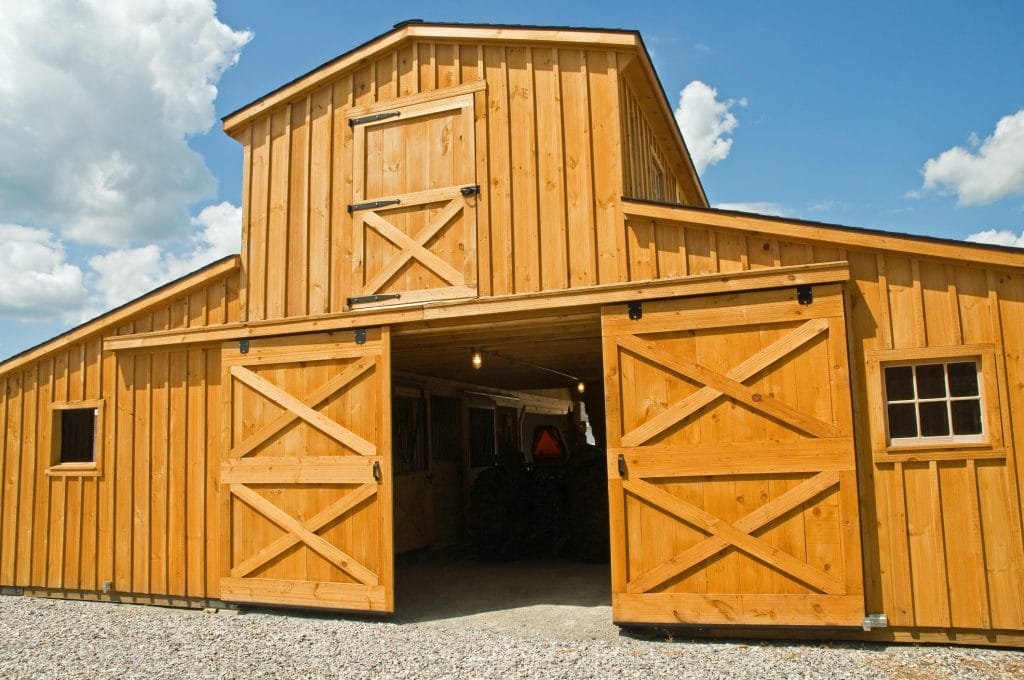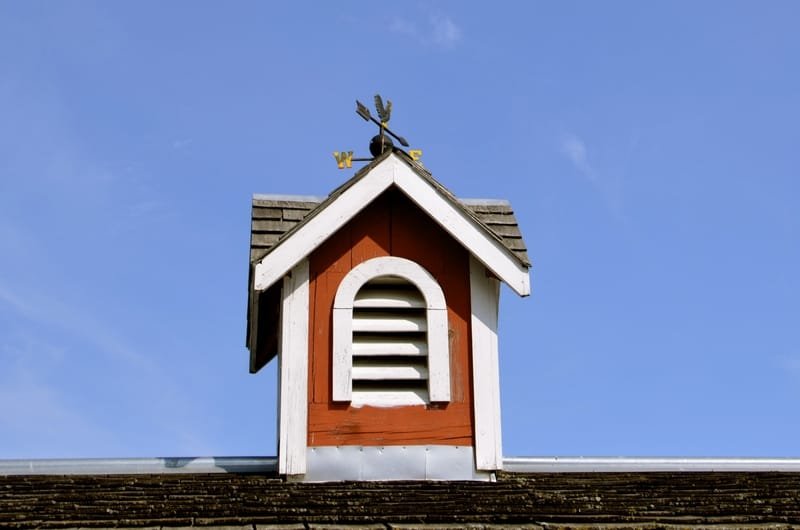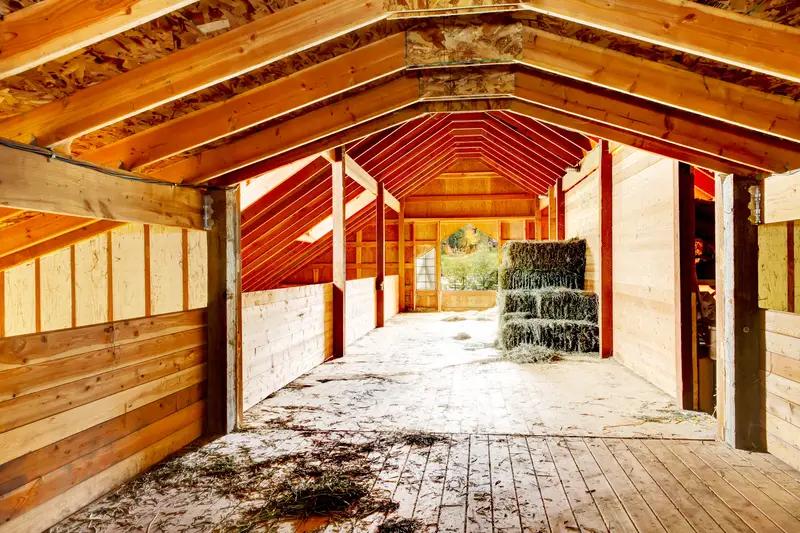This post contains affiliate links.
Building a new barn is a once-off job for many small-scale farmers. If you’re constructing your barn, you’ll probably have some concerns — situating the structure should be the least of your worries.
Generally, most barns face east or west. East and west facing barns will heat evenly throughout the day, while south-facing barns will be hotter and north-facing barns will be cooler. When positioning your barn, keep your personal needs in mind as much as the general weather conditions.
Your barn is where you’ll house your livestock and machinery while doubling as a storage area. The last thing you want to spend money on is structural repairs and maintenance costs. Let’s look at how to optimally position your barn to maximize the benefits of having one.

Which Direction To Face Your Barn
Your climate zone will be one of the main factors determining where you position your barn. Mostly, you’ll either live in warm climates or cooler ones.
In warm climates, you want your barn to be shaded from the southern sun to reduce the heat accumulation within the structure. In colder climates, you want to ensure that you orient your barn’s longest side towards the south to generate heat passively.
While the exact site of your barn will be specific to your needs and space, you’ll generally find that barns face east and west. This position allows the sun to heat the structure evenly and is especially beneficial in colder months.
Where To Situate Your Barn
If you haven’t ever built a barn, you may have to take some time to evaluate the details of placing the barn. Below are a few things to be mindful of when situating your barn to avoid additional costs and worry.
The Best Direction For Ideal Barn Ventilation
Ventilation is super important when designing your barn. While many believe that you have to close off your barn to all the elements, it may result in high ammonia levels, which can be detrimental to the animals’ respiratory systems.
Simply opening the window won’t resolve this problem, regardless of how much the wind blows. There are two ways you can ensure proper barn ventilation: natural ventilation and mechanical ventilation.
Natural Ventilation For Your Barn
A common way to increase ventilation is to create large openings in the side of the barn to allow air to flow through the structure. To achieve this, you want to open the side of the building that will allow the most air to flow through.
You want to prevent the wind from passing through in cooler climates, and in warmer temperatures, you want to encourage it. Consider using zip-down or roller curtains to allow air to pass through without chilling any of your animals.
Mechanical Ventilation For Your Barn
Always provide enough space for exhaust fan inlets. Placing your fans in tight spaces may result in unnecessary stress. If you go the mechanical route, talk to the fan suppliers to increase their effectiveness by adjusting the distance.
You also want to ensure that you place your fans as far away from the air inlet as possible — this will allow the air to be drawn through the building and increase air circulation.
The Best Direction For Barn Lighting
Natural light is desired in a barn as much as it is in a home, and you’ll find that the best natural light comes from the north. This light won’t cause your barn to overheat, so be sure to position your barn so that it’s not shaded by buildings or trees from the north.
Allowing loads of light to stream in will save you on electricity costs — so consider adding a few cupulas, skylights, and clerestory windows. Another way you can brighten everything up is by painting the interior walls in a light color. You can use this trick regardless of the direction your barn faces.

The Best Distance From Your Home To Your Barn
Trudging through the cold to get to your barn will only make you dread being in the space. You ideally want to place your barn 75 ft (22.86 m) from your main house. You just want it far away enough to limit the odors and noise. Learn more about how far your barn should be to your house in my article How Far Away Should Your Barn Be From Your House?
Besides personal access to the barn, you also want to consider how visitors (like veterinarians and delivery services) can access the building. One last thing you want to optimize is the placement of your barn in relation to your existing water, septic, and electrical lines. The closer you get to these access points, the more time and money you’ll save.
Tips On What To Do Before You Build Your Barn
Below you’ll find 5 things to consider before building your barn. It’s helpful to keep a file and document everything as it happens — you always want to be safe than have to pay the costs of wrongly situating your barn.
Here are a few things people with barns recommend you do before building yours:
Live Through The Seasons Before Determining The Direction Your Barn Should Face
Having just invested a lot of time and money into your property, you’re probably giddy with excitement to set up your new barn. Don’t do it straight away! Consider looking at the lay of the land before you build your barn.
Just like you don’t want to build a pool where the leaves gather, and you don’t want to situate your barn where water and dust accumulate. You essentially want to avoid having to dig a trench and pay water damage repair costs or find yourself constantly sweeping leaves and debris away.
Once you have lived through a full range of seasons on your property you then know how the wind blows, what direction the weather tends to come from, and any general quirks of the land.
Optimize Your Hay Storage
Hay bales are large and can be difficult to store — when you’re constructing your barn, consider the space you’ll need to access and store them comfortably.
One way you can do this is to load up the back of your truck and reverse through a sliding door — this way, you can easily open and close the storage area, push the hay off, and close it back up again.
If you’re buying bales in bulk, you may want to consider optimizing your barn space to accommodate the amount you usually house.

Determine Your Wash Stall And Feed Room Sizes
Often the wash stall is larger than the size of the feed room — not the most optimal layout considering you’re probably going to feed your animals more often than you wash them.
Building your barn to optimize storage space is vital. You want to ensure that you have more than enough space to store feed, medications, supplies, saddle racks, supplements, and whatever else the animals may need.
Optimize your wash stall, and you’ll find yourself left with ample space to store your feed and accompanied bits and pieces.
Perfect The Placement Of Your Feed And Tack Room
Do not place your feed or tack room in the center of your barn. You want to optimize your time and energy, and dragging feed around isn’t any way to do that.
If you have the option, build your feed and tack room around load-bearing walls. This way, you’ll be able to utilize vertical space that you can’t in rooms consisting of sheetrock.
Install Multi-directional Gates
It’s always a good idea to install multi-directional exterior gates. Installing this type of gate will allow you to quickly move between spaces when you’re preoccupied with other matters.
Be Mindful Of Zoning Requirements When Building Your Barn
Before you get to build your dream barn, you want to look into your area’s zoning requirements. You’ll have to comply with your local development codes, which can influence where you can place the barn.
On occasion, you may have to account for design and community requirements — this can include anything from the barn’s design to where it’s situated on your property. Shared driveways, public and private utilities, and property easements can also determine where you situate your barn.
Final Thoughts
A lot goes into designing a barn. You want to ensure your animals, feed, equipment, and hay bales are as safe as they can be. Buildings or trees from the north do not shade it. Optimizing the orientation of your barn can be helpful when it comes to saving money, maintaining the structural integrity of the barn, and increasing its longevity.
Try to face your barn towards the east or west, and make use of all the natural light you receive from the north to create a barn that will stand for centuries to come.

